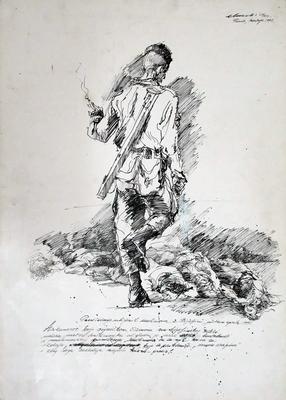Drawing the War: Bosnia 1992-1995
Before the war, Ekmečić was an academic painter whose subjects ranged from nudes to landscapes and panoramas. In 1992, in a time in which an artist was not allowed to keep silent, he became a war artist for the urge of documenting the destruction of his country
War has always been a subject of art. In the course of history, artists have depicted famous battles, and soldiers and civilians caught in the midst of war. As reminded us by Susan Sontag in her pivotal essay Regarding the Pain of Others, the practice of representing atrocious suffering entered the history of images with a particular subject, that of ‘the sufferings endured by a civilian population at the hands of a victorious army on the rampage’.
The theme emerged when Jacques Callot published eighteen etching titled Les Miseres et Les Malheurs de la Guerre (The Miseries and Misfortunes of War) in 1633, depicting the atrocities committed against civilians during the invasion and occupation of his native Lorraine in the early 1630s. During the XX century, a shift happened towards a more personal response to conflicts. This approach increasingly attracted high-profile artists and the work produced became more probing, challenging and thought-provoking.
The destruction of Bosnia-Herzegovina during the 1992-1995 war, documented by Bosnian artist Mevludin Ekmečić (b. 1929), radically transformed the aesthetics and contents used by local artists. When the war broke out, Ekmečić was forced to leave the country and took refuge in Paris. During the time of his exile, he transposed on paper the shocking images broadcasted on TV and newspapers by war journalists who were covering the Bosnian conflict, together with stories that he had collected from eyewitnesses.
Ekmečić produced a black and white chronicle of the Bosnian war consisting of 77 drawings, gathered under the title Genocide Upon the Bosniaks 1992-1995, which he later divided by subjects: ethnic cleansing, camps, rapes, refugees, children, cultural heritage, how to survive, and graves. Each drawing was accompanied by the artist’s drawn notes in which he attempted to describe in words the images that he had frenetically sketched on paper with black ink.
His pictures display the intents of the campaign against Bosnia and Herzegovina, its extent and character, specifically focusing on the ‘terrible genocide upon the people which I belong to’, as he told, and depicting astonishing scenes of savagery and suffering. A catalogue which gathered all drawings for the first time was printed in 1996; it is reported that part of these pictures was published in Bosnian and French media and showed in France and Belgium. Ekmečić later donated all the drawings to the Bosniak Institute in Sarajevo, where they are now conserved.
The exhibition Mevludin Ekmečić. Drawing the War: Bosnia 1992-1995, on display in June 2017 at Duplex100m2 gallery in Sarajevo as part of the program of the WARM Festival 2017, organised by the WARM Foundation from Paris and realised in collaboration with the Bosniak Institute of Sarajevo, presented a selection of 35 drawings.
Among them, visitors could look at familiar images such as the soldier kicking a woman lying face down on the street in Bjeljina, which had become sadly famous thanks to Ron Haviv’s photograph from 1992, the burning of the Sarajevo National Library, the pictures of segregated men in the Omarska concentration camp, or of the refugees from Srebrenica. Ekmečić’s pictures can be considered among the most significant artworks dealing with the conflict in Bosnia-Herzegovina.
Their originality and truth-telling ferocity voice the full range of emotions aroused in the artist by the spectacle of collective violence and destruction. This exhibition is an attempt to show the importance of the artist’s opus which successfully catalogues the brutality and fatal consequences of war in such a stark and confrontational manner that inevitably remind of The Disasters of War by Goya.
Before the war, Ekmečić was an academic painter whose subjects ranged from nudes, portraits, and motifs from Baščaršija to paintings of landscapes and panoramas. In 1992, in a time in which an artist was not allowed to keep silent, as he would later affirm, he became a war artist for the urge of documenting the destruction of his country, the violation of human rights and the effects of the war on individuals.
Mevludin Ekmecic, together with numerous other artists from Bosnia-Herzegovina, reflects in his artistic positions the traumas of war. Artists from the region, engaging with war memories, offer a precious occasion of debate for local communities.
The exhibition
The exhibition Mevludin Ekmečić. Drawing the War: Bosnia 1992-1995 is part of the program of the WARM Festival 2017, organised by the WARM Foundation and its president Rémy Ourdan, and it is realised in collaboration with the Bosniak Institute – Adil Zulfikarpašić Foundation and its director Amina Rizvanbegović Džuvić. The show was on display at the Duplex100m2 gallery in Sarajevo, directed by Pierre Courtin, from June 28th to July 2nd, 2017. The drawings are currently on display at the Bosniak Institute – Adil Zulfikarpašić Foundation until August 15th, 2017.
Tag:
Read more
11/05/2006, Risto Karajkov








